Chinese Cooking Matrix
中国八大菜系的英文
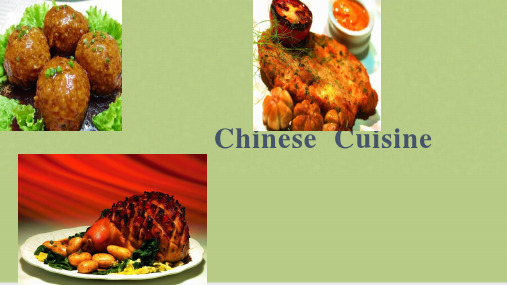
● Guangdong cuisine is creative with an emphasis on artistic presentation.
糖醋咕噜肉 Sweet and Sour Pork with Fat
Including local cuisines of Xiangjiang Region, Dongting Lake and Xiangxi coteau, Hunan is known for its use of chili pepper(红辣椒) and shallot(葱) ,characterized by its
白切鸡
糖醋咕噜肉
● Guangdong cuisine is creative with an emphasis on artistic presentation. The cuisine is considered light(淡), crisp(酥)and fresh(鲜).
Fujian Cuisine
鱼 香 肉 丝 Fi s h 火腿炖甲鱼 Ham stewed turtle
佛跳墙 Monk Jumps over Wall
flavored
shredded
pork
with
garlic
sauce
Hunan cuisine
Famous Dishes
麻婆豆腐 Mapo Tofu 醉排骨 Spare Ribs in Wine Sauce
霸王别姬 Farewell to my concubine 松鼠鳜鱼 Sweet and sour mandarin fish 东坡肉 Braised Dongpo Pork 叫花鸡 Beggars Chicken 西湖醋鱼 Steamed grass carp in vvinegar gravy 腊味合蒸 Mixed cured meat 剁椒鱼头 Steamed fish head with diced hot red peppers 红烧猪蹄 Braised pork trotter with soya sauce
介绍中国传统烹饪英语作文

介绍中国传统烹饪英语作文中国烹饪艺术,源远流长,承载着深厚的文化底蕴与独特的饮食哲学。
其博大精深的技艺、丰富的菜系、千变万化的口味,使之在全球范围内享有极高声誉。
以下,我们将以中英文对照的方式,深入探索中国传统烹饪的魅力。
Chinese cuisine is a culinary art with a profound history and rich cultural connotations, embodying unique dietary philosophies. Its vast array of techniques, diverse regional cuisines, and ever-changing flavors have earned it worldwide acclaim.【菜系繁多,地域风味】中国幅员辽阔,地理环境多样,孕育出八大菜系:鲁、川、粤、苏、浙、闽、湘、徽,各具特色。
如鲁菜,源于山东,讲究原汁原味,醇厚鲜美;川菜则以麻辣著称,展现四川人对味觉刺激的极致追求。
Each region boasts its distinct style, as exemplified by Shandong's Lu cuisine, which emphasizes natural flavors and rich umami, while Sichuan's spicy and numbing sensations reflect the locals' love for bold tastes.【烹饪手法精湛,食材搭配巧妙】中国传统烹饪技法繁复多样,炒、煎、蒸、炖、烤、卤等,无一不显匠心独运。
同时,厨师们擅长以“色、香、味、形、器”五要素协调菜肴,将食材的天然之美与烹饪的艺术性完美融合。
Masterful cooking techniques such as stir-frying, pan-frying, steaming, braising, roasting, and simmering in seasoned broth showcase the ingenuity of Chinese chefs. They skillfully harmonize the five elements of "color, aroma, taste, texture, and presentation," marrying the innate beauty of ingredients with the artistry of cooking.【药食同源,养生理念】中国传统烹饪深深植根于中医“药食同源”的理念,强调食物的营养价值与保健功能。
中国料理英语作文
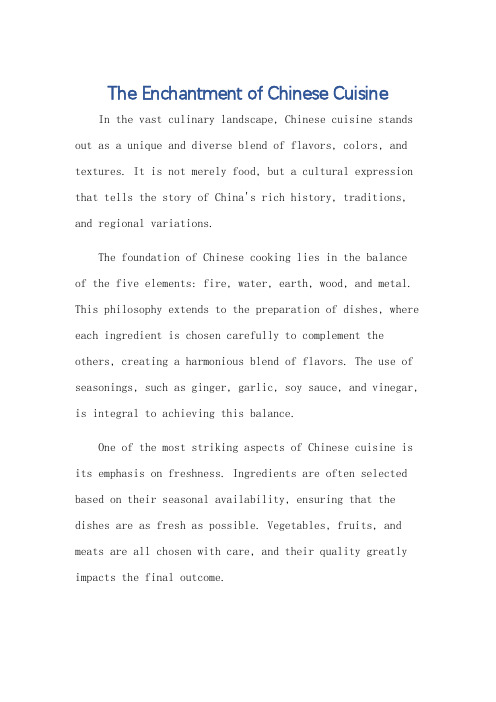
The Enchantment of Chinese CuisineIn the vast culinary landscape, Chinese cuisine stands out as a unique and diverse blend of flavors, colors, and textures. It is not merely food, but a cultural expression that tells the story of China's rich history, traditions, and regional variations.The foundation of Chinese cooking lies in the balance of the five elements: fire, water, earth, wood, and metal. This philosophy extends to the preparation of dishes, where each ingredient is chosen carefully to complement the others, creating a harmonious blend of flavors. The use of seasonings, such as ginger, garlic, soy sauce, and vinegar, is integral to achieving this balance.One of the most striking aspects of Chinese cuisine is its emphasis on freshness. Ingredients are often selected based on their seasonal availability, ensuring that the dishes are as fresh as possible. Vegetables, fruits, and meats are all chosen with care, and their quality greatly impacts the final outcome.Another noteworthy feature is the extensive use ofstir-frying, a cooking technique that preserves the nutrients and texture of the ingredients. This rapid cooking method, often done in a wok, brings out the inherent flavors of the food, making each bite a burst of taste and aroma.Chinese cuisine also boasts a wide array of cooking styles, each unique to a particular region. From the spicy Sichuan cuisine to the delicate Guangdong dishes, eachstyle reflects the local culture, climate, and ingredients. Dishes like Peking duck, Chongyang Festival cakes, and mapo tofu are just a few examples of the diverse flavors found throughout China.But beyond the taste, Chinese cuisine is also an art form. The presentation of dishes is often as important as the taste, with careful attention paid to color, shape, and texture. This aesthetic appeal adds to the overall dining experience, making it a sensory journey that goes beyond mere taste.In conclusion, Chinese cuisine is much more than just food; it's a cultural experience that combines flavors,textures, and visual appeal. It tells the story of China's diverse regions and rich history, offering a taste of its unique traditions and values. Whether you're a food loveror a culture aficionado, exploring Chinese cuisine is sureto be an enriching and memorable journey.**中国料理的魅力**在丰富多彩的烹饪领域中,中国料理以其独特和多样化的风味、色彩和口感脱颖而出。
以中国烹饪为主题的英语作文
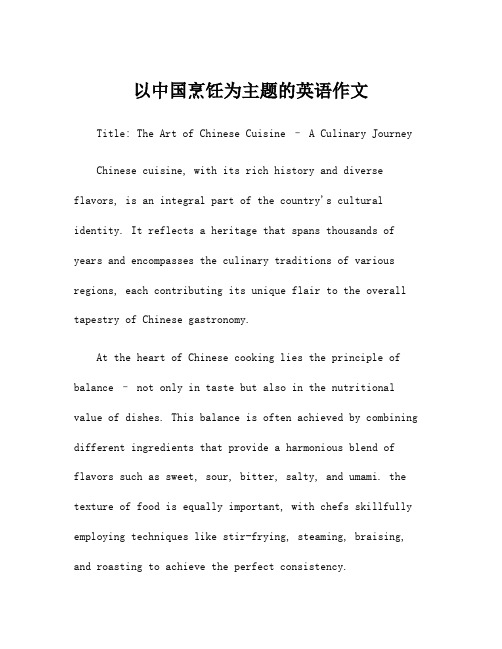
以中国烹饪为主题的英语作文Title: The Art of Chinese Cuisine – A Culinary Journey Chinese cuisine, with its rich history and diverse flavors, is an integral part of the country's cultural identity. It reflects a heritage that spans thousands of years and encompasses the culinary traditions of various regions, each contributing its unique flair to the overall tapestry of Chinese gastronomy.At the heart of Chinese cooking lies the principle of balance – not only in taste but also in the nutritional value of dishes. This balance is often achieved by combining different ingredients that provide a harmonious blend of flavors such as sweet, sour, bitter, salty, and umami. the texture of food is equally important, with chefs skillfully employing techniques like stir-frying, steaming, braising, and roasting to achieve the perfect consistency.Regional Varieties and SpecialtiesOne of the hallmarks of Chinese cuisine is its regional diversity. From the fiery spices of Sichuan in the southwestto the hearty stews of Dongbei in the northeast, each region boasts its own distinct style and flavor profile.Sichuan cuisine, for instance, is famous for its bold spiciness, thanks to the liberal use of garlic, chili peppers, and the unique Sichuan peppercorn. Dishes like Mapo Tofu and Kung Pao Chicken are staples that have gained international popularity for their complex interplay of heat and other flavors.Moving to the coastal areas of China, we find the Cantonese cuisine which emphasizes freshness and tenderness. Dim sum, a style of small, bite-sized portions served in bamboo steamers or on small plates, is emblematic of this region. Ingredients like seafood, pork, and vegetables areprepared in ways that highlight their natural flavors and textures.In the north, wheat-based foods like dumplings and noodles feature prominently due to the cooler climate. The Beijing-style roasted duck is an iconic dish that showcases the art of marinating, stuffing, and then roasting the bird to a crispy golden brown.Festivals and FoodChinese festivals are closely tied to food. During the Spring Festival, or Chinese New Year, families gather for a reunion dinner that includes dishes symbolizing good fortune and health. Dumplings shaped like ancient gold ingots are a must-have, representing wealth in the coming year. Fish is also a traditional dish, symbolizing surplus and abundance since the word for fish (yu) sounds like the word for surplus in Chinese.The Mid-Autumn Festival is another occasion where food plays a central role. Mooncakes, round pastries filled with sweet bean paste or lotus seed paste and sometimes containing salted egg yolks, are exchanged among family and friends to celebrate the full moon and express wishes for a prosperous future.Ingredients and TechniquesChinese cuisine places great emphasis on the quality and freshness of ingredients. Wet markets, where vendors sell everything from live seafood to fresh produce, are still popular venues for sourcing ingredients. Soy sauce, rice wine, and sesame oil are common seasonings that add depth and complexity to a dish.Techniques like stir-frying require precise control over heat and timing, allowing chefs to quickly cook ingredients while retaining their color, texture, and nutrients. Steaming is another popular method, especially for dim sum and otherdelicate dishes, as it preserves the subtle flavors and ensures tenderness.Innovation and AdaptationDespite its reverence for tradition, Chinese cuisine is not static. Chefs today are constantly innovating, incorporating global flavors and presenting traditional dishes in new and creative ways. As Chinese cuisine gains popularity around the world, it adapts to suit local tastes while maintaining its core principles.ConclusionThe art of Chinese cuisine is an ever-evolving journey that offers endless discovery and delight. With its myriad of flavors, techniques, and regional specialties, it invites both natives and foreigners alike to partake in a culinary heritage that is as rich as it is varied. Whether enjoyed in a bustling street-side eatery or a fine-dining restaurant, the experience of Chinese cuisine is a testament to theingenuity, creativity, and appreciation for the balance of nature embedded within this ancient culture.。
英语做饭国产作文
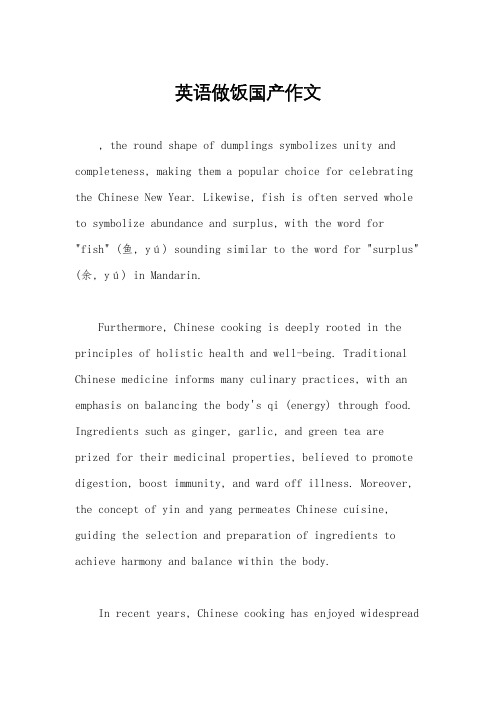
英语做饭国产作文, the round shape of dumplings symbolizes unity and completeness, making them a popular choice for celebrating the Chinese New Year. Likewise, fish is often served whole to symbolize abundance and surplus, with the word for "fish" (鱼, yú) sounding simi lar to the word for "surplus" (余, yú) in Mandarin.Furthermore, Chinese cooking is deeply rooted in the principles of holistic health and well-being. Traditional Chinese medicine informs many culinary practices, with an emphasis on balancing the body's qi (energy) through food. Ingredients such as ginger, garlic, and green tea are prized for their medicinal properties, believed to promote digestion, boost immunity, and ward off illness. Moreover, the concept of yin and yang permeates Chinese cuisine, guiding the selection and preparation of ingredients to achieve harmony and balance within the body.In recent years, Chinese cooking has enjoyed widespreadpopularity on the global stage, with restaurants and food enthusiasts around the world embracing its flavors and techniques. From the humble neighborhood noodle shop to the Michelin-starred fine dining establishment, Chinese cuisine continues to captivate diners with its bold flavors, innovative dishes, and rich cultural heritage.In conclusion, Chinese cooking is much more than just preparing food; it is a reflection of history, culture, and philosophy. Through its emphasis on harmony, freshness, and tradition, Chinese cuisine invites people from all walks of life to embark on a culinary journey that celebrates diversity and fosters understanding. As we savor each mouthful of steaming hot dumplings or fragrant bowl of noodle soup, let us not only satisfy our hunger but also nourish our souls with the richness of Chinese culinary tradition.。
介绍中国八大菜系之一的英语作文
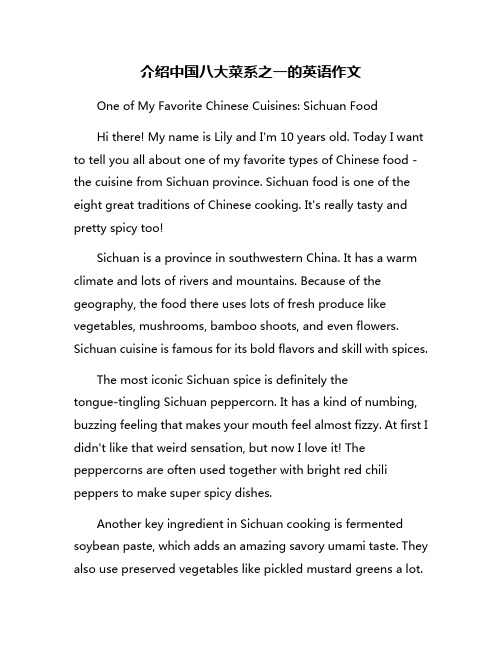
介绍中国八大菜系之一的英语作文One of My Favorite Chinese Cuisines: Sichuan FoodHi there! My name is Lily and I'm 10 years old. Today I want to tell you all about one of my favorite types of Chinese food - the cuisine from Sichuan province. Sichuan food is one of the eight great traditions of Chinese cooking. It's really tasty and pretty spicy too!Sichuan is a province in southwestern China. It has a warm climate and lots of rivers and mountains. Because of the geography, the food there uses lots of fresh produce like vegetables, mushrooms, bamboo shoots, and even flowers. Sichuan cuisine is famous for its bold flavors and skill with spices.The most iconic Sichuan spice is definitely thetongue-tingling Sichuan peppercorn. It has a kind of numbing, buzzing feeling that makes your mouth feel almost fizzy. At first I didn't like that weird sensation, but now I love it! The peppercorns are often used together with bright red chili peppers to make super spicy dishes.Another key ingredient in Sichuan cooking is fermented soybean paste, which adds an amazing savory umami taste. They also use preserved vegetables like pickled mustard greens a lot.Oh, and Sichuan cooks are masters at cooking with different kinds of cooking oil for extra fragrance and aroma.Some famous Sichuan dishes I really enjoy are mapo tofu, kung pao chicken, twice cooked pork, and dandan noodles. Mapo tofu is soft tofu in a super spicy sauce with ground pork. Even though it's very hot and numbing, it's so delicious! The tender tofu balances out the heat really well.Kung pao chicken is a stir-fry with chicken, peanuts, vegetables, and those special Sichuan peppercorns. I like all the different textures and how the sauce is savory, spicy and a bit sweet all at once. Twice cooked pork has cool name - it's pork belly that gets boiled first to make it tender, then stir-fried so the outside gets crispy and coated in a yummy sauce.As for dandan noodles, they're thick noodles in a sauce made from chili oil, soy sauce, vinegar, and those numbing Sichuan peppercorns again. You can add meat or vegetables on top. I really love slurping up those chewy, slippery noodles covered in that crazy flavorful sauce!My other favorite Sichuan dishes are water-boiled fish and mapo tofu. For the water-boiled fish, they cook fresh fish in a super intense broth of chilis, Sichuan peppercorns and a bunch of other spices. The broth is so fragrant and delicious for dippingthe tender fish in. Mapo tofu is soft tofu in a crazy spicy sauce with ground pork. I love how the velvety tofu balances out the numbing heat.Sichuan food can seem a bit scary at first because of all the chilies and tongue-tingling sensations. But I've grown to really appreciate all the incredible flavors and sensations. The bold spices, the savory fermented notes, the fresh produce - it's such a delightful cuisine!Sichuan cooks are also awesome at using different cooking techniques like steaming, smoking, braising, dry-frying and more to make dishes with amazing textures. Take smoked beef for example - the beef gets smoked over a special type of smoky tea camphor until it's super fragrant and tender.Another thing I love about Sichuan cuisine is all the different snacks and street foods. Things like spicy wonton soup, dandan noodles from a street stall, fried beef ribbons, muchu chicken - they all taste incredible! I could munch on those snacks all day.Well, I hope I've convinced you to give Sichuan cuisine a try if you haven't already! With its intriguing flavor combinations, tingling sensations, and amazing diversity of dishes, it's one of the most unique and delicious cuisines in the world. Just be prepared for some serious spice and numbingly delicious flavors!Let me know if you have any other questions about this awesome food tradition.。
中国菜常用的烹调方法英文
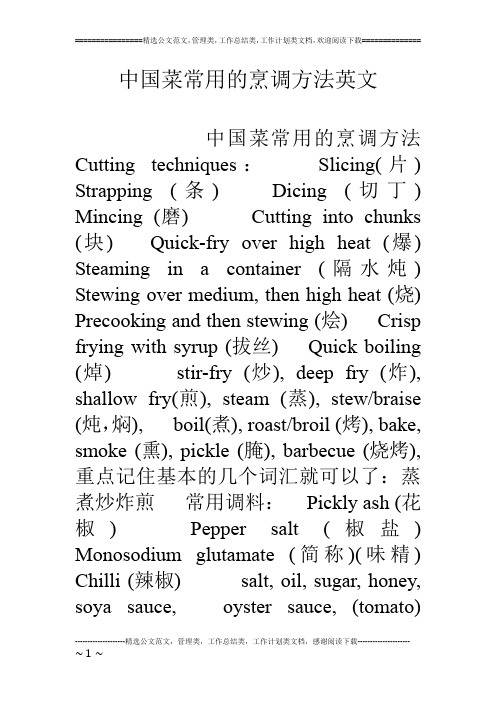
中国菜常用的烹调方法英文中国菜常用的烹调方法Cutting techniques:Slicing(片) Strapping (条) Dicing (切丁) Mincing (磨) Cutting into chunks (块) Quick-fry over high heat (爆) Steaming in a container (隔水炖) Stewing over medium, then high heat (烧) Precooking and then stewing (烩) Crisp frying with syrup (拔丝) Quick boiling (焯) stir-fry (炒), deep fry (炸), shallow fry(煎), steam (蒸), stew/braise (炖,焖), boil(煮), roast/broil (烤), bake, smoke (熏), pickle (腌), barbecue (烧烤), 重点记住基本的几个词汇就可以了:蒸煮炒炸煎常用调料:Pickly ash (花椒) Pepper salt (椒盐) Monosodium glutamate (简称)(味精) Chilli (辣椒) salt, oil, sugar, honey, soya sauce, oyster sauce, (tomato)ketchup, vinegar, cumin powder(孜然), mustard, , chicken essence, pepper/chilli, ginger(姜), garlic(蒜), shallot (葱), leek (韭) 最后,给大家几道中国菜名翻译:其实规则很简单,就是烹饪方法+主料+配料+风味蛋炒饭stir-fried rice with egg 凉拌黄瓜fresh cucumber with bean sauce; mixed fresh cucumber 醋溜土豆potato with vinegar flavor 糖醋排骨fried spareribs with sweet and sour sauce 红烧肉braised pork with soy sauce 宫爆鸡丁stir-fried diced chicken with chili sauce and peanuts 清蒸鱼steamed fish 肉丝面noodles with slice pork 中国特色菜:Aubergine(茄子)、DwarfBean(刀豆)、Chillies(辣椒)、Eddoes(小芋头)、Spinach(菠菜)、Beansprots(绿豆芽)、Springonions(葱)、Leeks(大葱)、Garlic(大蒜)、Ginger(生姜)、Co riander(香菜)、Greenbean(绿豆)、RedBean(红豆)、Driedblackmushroom(冬菇)、Tigerlilybuds(金针菜)、Mu-er(木耳)、Cashewnuts(腰果)、Silknoodles(粉丝)、SeavegetableorSeaweed(海带)、Tofu(豆腐)、Driedfish(鱼干)。
中国菜单 英语作文
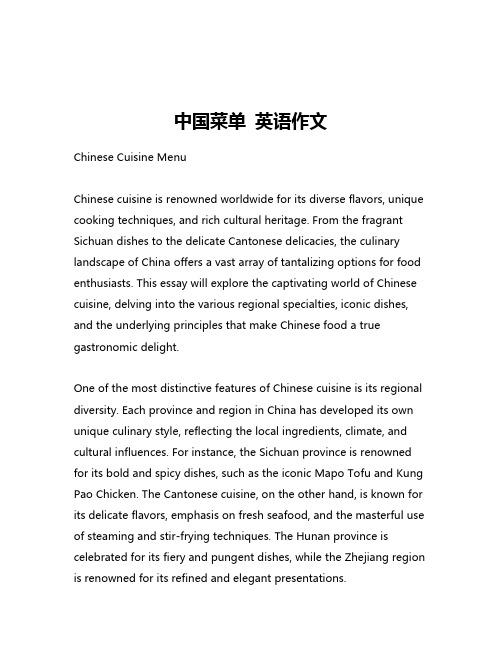
中国菜单英语作文Chinese Cuisine MenuChinese cuisine is renowned worldwide for its diverse flavors, unique cooking techniques, and rich cultural heritage. From the fragrant Sichuan dishes to the delicate Cantonese delicacies, the culinary landscape of China offers a vast array of tantalizing options for food enthusiasts. This essay will explore the captivating world of Chinese cuisine, delving into the various regional specialties, iconic dishes, and the underlying principles that make Chinese food a true gastronomic delight.One of the most distinctive features of Chinese cuisine is its regional diversity. Each province and region in China has developed its own unique culinary style, reflecting the local ingredients, climate, and cultural influences. For instance, the Sichuan province is renowned for its bold and spicy dishes, such as the iconic Mapo Tofu and Kung Pao Chicken. The Cantonese cuisine, on the other hand, is known for its delicate flavors, emphasis on fresh seafood, and the masterful use of steaming and stir-frying techniques. The Hunan province is celebrated for its fiery and pungent dishes, while the Zhejiang region is renowned for its refined and elegant presentations.One of the most iconic Chinese dishes is the Peking Duck, which originated in the imperial kitchens of Beijing. This dish features a crispy-skinned roasted duck, served with delicate pancakes, scallions, and a sweet hoisin sauce. The preparation of Peking Duck is a true culinary art, requiring meticulous attention to detail and a deep understanding of the cooking process. The duck is meticulously prepared, with the skin being carefully scored and the meat being roasted to perfection, resulting in a harmonious balance of flavors and textures.Another quintessential Chinese dish is the Dim Sum, a Cantonese culinary tradition that involves a wide array of small, bite-sized dishes served in steamer baskets or on small plates. Dim Sum encompasses a diverse range of items, from delicate dumplings and savory buns to sweet custard tarts and unique delicacies like chicken feet. The experience of enjoying Dim Sum is as much about the social aspect as it is about the food, with families and friends gathering around the table to share and savor these delightful morsels.Beyond the iconic dishes, Chinese cuisine also boasts a wealth of lesser-known regional specialties that are equally captivating. The Xinjiang region, for example, is renowned for its fragrant lamb dishes, such as the Roasted Lamb Skewers and the Lamb Pilaf, which showcase the influence of Central Asian culinary traditions. TheYunnan province, with its diverse ethnic minority communities, offers a unique blend of flavors, including the renowned Crossing the Bridge Noodles, a dish that features a rich, aromatic broth and a variety of toppings.One of the fundamental principles that underpin Chinese cuisine is the concept of balance and harmony. Chinese chefs strive to create dishes that are well-balanced in terms of flavors, textures, and even the yin-yang energy. This philosophy is reflected in the use of the five basic tastes – sour, sweet, bitter, salty, and umami – and the careful selection of ingredients to achieve a harmonious interplay of flavors. Additionally, the presentation of Chinese dishes is often considered an art form, with chefs paying meticulous attention to the visual appeal of the dishes, using vibrant colors, intricate garnishes, and elegant plating techniques.Another key aspect of Chinese cuisine is the emphasis on seasonality and the use of fresh, high-quality ingredients. Chinese chefs place a great importance on sourcing the best and most seasonal produce, seafood, and meats to ensure the freshness and quality of their dishes. This commitment to using the best ingredients is evident in the way Chinese cuisine celebrates the natural flavors of the ingredients, allowing them to shine without excessive manipulation or overpowering seasonings.The influence of Chinese cuisine can be seen around the world, as it has inspired countless culinary traditions and fusion cuisines. From the ubiquitous Chinese takeout dishes in Western countries to the increasing popularity of authentic Chinese regional cuisines, the impact of Chinese food on the global culinary landscape is undeniable. As more people are exposed to the depth and complexity of Chinese cuisine, the appreciation and understanding of this rich culinary heritage continue to grow.In conclusion, Chinese cuisine is a captivating and multifaceted culinary tradition that offers a diverse array of flavors, techniques, and regional specialties. From the iconic Peking Duck to the delicate Dim Sum, and the fiery Sichuan dishes to the refined Cantonese delicacies, Chinese food is a true gastronomic adventure that celebrates the balance, harmony, and the use of high-quality ingredients. As the world continues to embrace the wonders of Chinese cuisine, the appreciation and understanding of this rich culinary heritage will only continue to deepen, inspiring food enthusiasts and chefs alike to explore the boundless possibilities of this extraordinary culinary tradition.。
为一家中国餐馆设计一分菜单英语作文
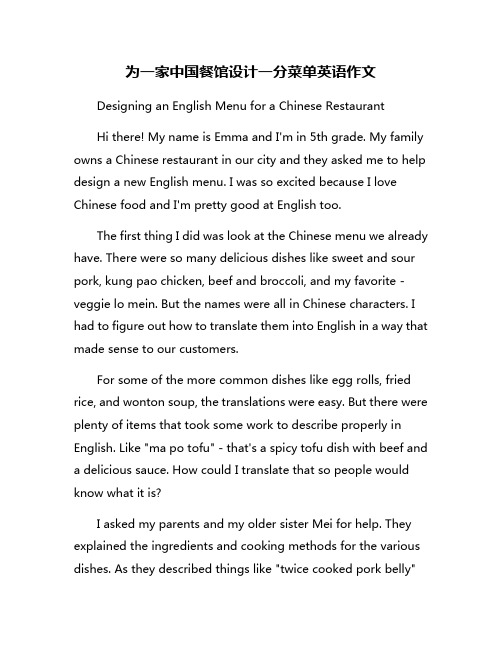
为一家中国餐馆设计一分菜单英语作文Designing an English Menu for a Chinese RestaurantHi there! My name is Emma and I'm in 5th grade. My family owns a Chinese restaurant in our city and they asked me to help design a new English menu. I was so excited because I love Chinese food and I'm pretty good at English too.The first thing I did was look at the Chinese menu we already have. There were so many delicious dishes like sweet and sour pork, kung pao chicken, beef and broccoli, and my favorite - veggie lo mein. But the names were all in Chinese characters. I had to figure out how to translate them into English in a way that made sense to our customers.For some of the more common dishes like egg rolls, fried rice, and wonton soup, the translations were easy. But there were plenty of items that took some work to describe properly in English. Like "ma po tofu" - that's a spicy tofu dish with beef and a delicious sauce. How could I translate that so people would know what it is?I asked my parents and my older sister Mei for help. They explained the ingredients and cooking methods for the various dishes. As they described things like "twice cooked pork belly"and "dry fried green beans," I wrote down notes to use for the descriptions.Once I had all the dishes listed out, I started putting them into categories like Appetizers, Soups, Beef Dishes, Seafood Dishes, and so on. I made sure to have a Vegetarian section too for our customers who don't eat meat. I wanted the menu to be really easy to read and understand.For the descriptions, I tried to use super clear and simple language. Like for the kung pao chicken, I wrote "diced chicken, peanuts, vegetables, and chili peppers in a spicy sauce." That way people know exactly what they are ordering. Of course, for things like dumplings and noodles, I didn't need to go into too much detail.I also added some fun facts and explanations throughout the menu. For example, next to the Hot and Sour Soup, I wrote "This classic soup gets its flavor from vinegar, pepper, and loads of delicious ingredients like mushrooms and tofu." I thought little blurbs like that would help get people excited to try new dishes.Another challenge was deciding if I should describe certain ingredients using the Americanized name or the Chinese name. Like, should I call it a "Chinese doughnut" or a "you tiao"? Should I say "Chinese broccoli" or "gai lan"? In the end, I decided to usethe more familiar name but then put the Chinese name in parentheses next to it.Once I had everything written up, I had my parents and sister proofread it. I'm so glad I did because they caught a bunch of little mistakes I made, like referring to a shrimp dish as a "prawn" dish. They also helped me reorganize a few sections to make them more readable.Finally, it was time for the fun part - designing how the menu would actually look! I didn't want it to just be words on a boring white piece of paper. So I decorated the borders with cute cartoon drawings of my favorite Chinese dishes. I made the section headers look kind of fancy, and used different colored texts and boxes to make things pop out more.I also added some quick symbols so people could easily see if a dish is vegetarian, spicy, or contains nuts. Safety is important when you have food allergies! Oh and I didn't forget about dessert - I dedicated a whole page to our yummy sweet treats like mango pudding and almond cookies.When I showed my final menu to my parents, they were so proud and happy. My dad gave me the biggest hug and said customers are going to love being able to read about all our tasty foods in English. Yay!Designing this menu was a lot of work but it was totally worth it. I can't wait for it to be printed so I can show it to all my friends. I hope it really helps our restaurant welcoming more new customers. If you're ever in town, please come visit and don't forget to order the lo mein!。
中国人的菜单英语作文
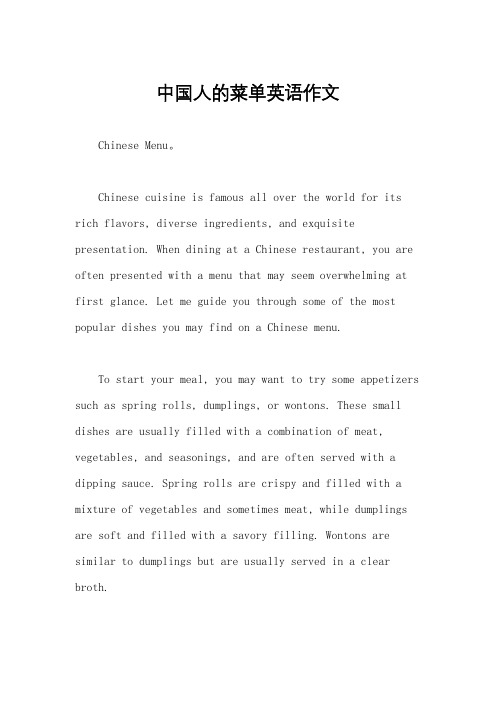
中国人的菜单英语作文Chinese Menu。
Chinese cuisine is famous all over the world for its rich flavors, diverse ingredients, and exquisite presentation. When dining at a Chinese restaurant, you are often presented with a menu that may seem overwhelming at first glance. Let me guide you through some of the most popular dishes you may find on a Chinese menu.To start your meal, you may want to try some appetizers such as spring rolls, dumplings, or wontons. These small dishes are usually filled with a combination of meat, vegetables, and seasonings, and are often served with a dipping sauce. Spring rolls are crispy and filled with a mixture of vegetables and sometimes meat, while dumplings are soft and filled with a savory filling. Wontons are similar to dumplings but are usually served in a clear broth.For the main course, you can choose from a wide variety of dishes, including stir-fried dishes, steamed dishes, and braised dishes. Stir-fried dishes are cooked quickly over high heat with a combination of meat, vegetables, and sauces. Some popular stir-fried dishes include Kung Pao chicken, beef with broccoli, and sweet and sour pork. Steamed dishes are cooked by steaming the ingredients over boiling water, which helps to retain their natural flavors and nutrients. Steamed fish, steamed buns, and steamed dumplings are all popular choices. Braised dishes are cooked slowly in a flavorful sauce until the meat is tender and the flavors have melded together. Braised pork belly, braised tofu, and braised beef are all classic examples of this cooking method.No Chinese meal is complete without a side of rice or noodles. Fried rice, steamed rice, and noodle dishes areall popular choices to accompany your main course. Fried rice is cooked with a combination of meat, vegetables, and eggs, while steamed rice is a simple and versatile side dish. Noodle dishes can be stir-fried or served in a soup, and can be made with a variety of meats, vegetables, andsauces.To finish off your meal, you may want to try some traditional Chinese desserts such as sweet red bean soup, sesame balls, or mango pudding. These desserts are often sweet and served in small portions to cleanse the palate after a savory meal.In conclusion, a Chinese menu offers a wide variety of dishes to choose from, each with its own unique flavors and cooking techniques. Whether you are a fan of spicy stir-fries, delicate steamed dishes, or hearty braised meats, there is something for everyone on a Chinese menu. So next time you dine at a Chinese restaurant, don't be afraid to explore the menu and try something new. You may just discover a new favorite dish!。
为一家中国餐馆设计一份菜单英语作文
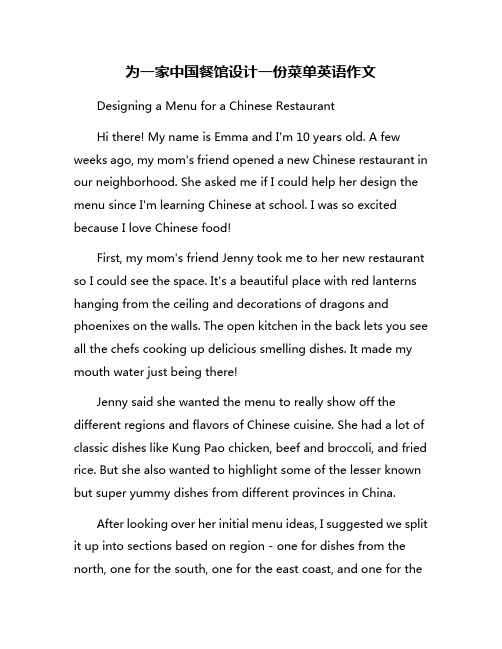
为一家中国餐馆设计一份菜单英语作文Designing a Menu for a Chinese RestaurantHi there! My name is Emma and I'm 10 years old. A few weeks ago, my mom's friend opened a new Chinese restaurant in our neighborhood. She asked me if I could help her design the menu since I'm learning Chinese at school. I was so excited because I love Chinese food!First, my mom's friend Jenny took me to her new restaurant so I could see the space. It's a beautiful place with red lanterns hanging from the ceiling and decorations of dragons and phoenixes on the walls. The open kitchen in the back lets you see all the chefs cooking up delicious smelling dishes. It made my mouth water just being there!Jenny said she wanted the menu to really show off the different regions and flavors of Chinese cuisine. She had a lot of classic dishes like Kung Pao chicken, beef and broccoli, and fried rice. But she also wanted to highlight some of the lesser known but super yummy dishes from different provinces in China.After looking over her initial menu ideas, I suggested we split it up into sections based on region - one for dishes from the north, one for the south, one for the east coast, and one for thewest. That way people could easily find different flavors they might want to try.For the northern section, we included dishes likehand-pulled noodles, Beijing duck, and soup dumplings which are famous in places like Beijing and Shandong. Mom always makes jiaozi (dumplings) for Chinese New Year so I was really excited to have those on the menu.Then for the southern section, we chose dishes that originated in Sichuan, Hunan, and Guangdong provinces which are known for their spicy and savory flavors. We included classics like Kung Pao chicken, mapo tofu, and dim sum dishes like char siu bao (barbecue pork buns). One of my favorites is the dan dan noodles from Sichuan with the savory, slightly numbing sauce.For the eastern coastal region, we picked dishes that use a lot of fresh seafood and veggies. There are stir-fries with shrimp, scallops and bok choy, steamed whole fish, and Buddha's delight which is a popular vegetarian dish. We also included some dim sum items that are iconic in cities like Shanghai like xiaolongbao (soup dumplings).Finally, for the western region, we chose hearty dishes that originated along the Silk Road in places like Xinjiang and Shaanxi provinces. There are lamb and cumin stir-fries, naan breads, andnoodle dishes with thick, flavorful sauces. One item I'm really excited to try is the big plate chicken from Xinjiang which looks so delicious!After deciding on all the dishes, I helped Jenny write descriptions to explain what was in each one and where it was from in China. We used descriptive words to make them sound really appetizing like "savory", "perfectly spiced", "fragrant", and "mouthwatering." The goal was to intrigue people to try new dishes they might not be familiar with.For the design of the menu itself, we used elements of traditional Chinese art and calligraphy. We found a beautiful Chinese font for the titles and descriptions. At the top there's a dragon logo that Jenny's friend designed, with her restaurant's name written in Chinese characters underneath.Each section has an illustration of a scenery from that region - for example, there are pagodas and karst mountains for the southern section and the Great Wall for the northern dishes. We made the icons and graphics bold and colorful using reds, blues, and golds to make them really pop.On the back cover, I wrote a little introduction in both English and Chinese about the different regional culinarytraditions showcased in the menu. My Chinese teacher helped me make sure all the translations were accurate.After a few rounds of edits and revisions, the menu was finally ready to go to print. I was so proud when I saw the finished product! It looked beautiful and made me so hungry for all the amazing dishes inside.Designing this Chinese menu was such a fun experience. I learned a lot about the diverse cuisines from China's different regions. It made me want to travel there someday to taste all the authentic flavors and dishes for myself. For now, I'll have to settle for enjoying Jenny's delicious restaurant!If you're ever in my neighborhood, you'll have to stop by and let me know what you think of the menu. Maybe I'll even get to try out as a restaurant hostess or server one day and show off my Chinese skills. Ok, time for me to go practice my tones. Zai jian (Bye)!。
“美食节目”英语怎么说
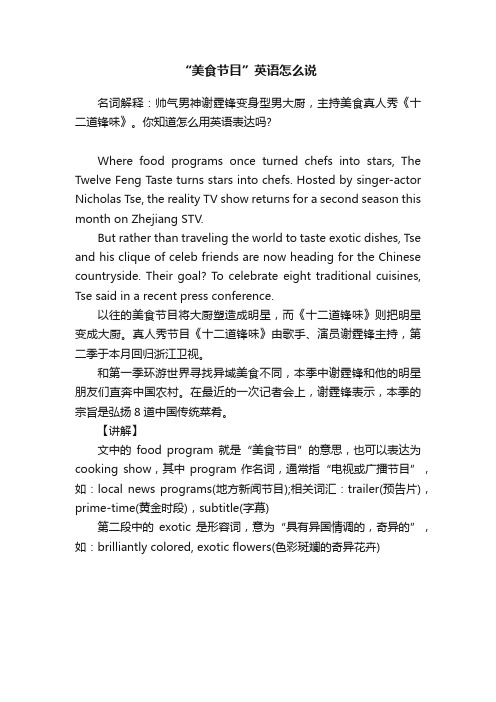
“美食节目”英语怎么说名词解释:帅气男神谢霆锋变身型男大厨,主持美食真人秀《十二道锋味》。
你知道怎么用英语表达吗?Where food programs once turned chefs into stars, The Twelve Feng Taste turns stars into chefs. Hosted by singer-actor Nicholas Tse, the reality TV show returns for a second season this month on Zhejiang STV.But rather than traveling the world to taste exotic dishes, Tse and his clique of celeb friends are now heading for the Chinese countryside. Their goal? To celebrate eight traditional cuisines, Tse said in a recent press conference.以往的美食节目将大厨塑造成明星,而《十二道锋味》则把明星变成大厨。
真人秀节目《十二道锋味》由歌手、演员谢霆锋主持,第二季于本月回归浙江卫视。
和第一季环游世界寻找异域美食不同,本季中谢霆锋和他的明星朋友们直奔中国农村。
在最近的一次记者会上,谢霆锋表示,本季的宗旨是弘扬8道中国传统菜肴。
【讲解】文中的food program就是“美食节目”的意思,也可以表达为cooking show,其中program作名词,通常指“电视或广播节目”,如:local news programs(地方新闻节目);相关词汇:trailer(预告片),prime-time(黄金时段),subtitle(字幕)第二段中的exotic是形容词,意为“具有异国情调的,奇异的”,如:brilliantly colored, exotic flowers(色彩斑斓的奇异花卉)。
the Eight Culinary(烹饪的) Traditions of China
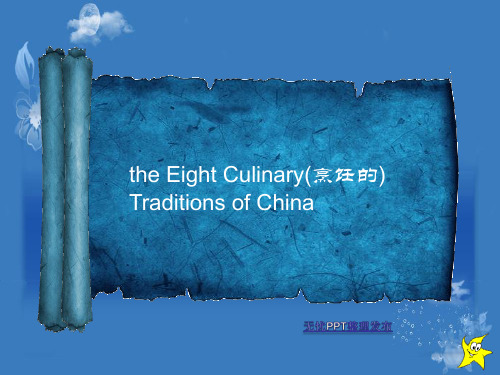
Chinese 佛跳墙 蚵仔煎 肉骨茶 包心魚丸 淡糟香螺片 雞湯汆海蚌 干貝蘿蔔 醉排骨 東壁龍珠 黄燜田雞 五彩蝦松 五彩珍珠扣
Su (Jiangsu, Huaiyang cuisine)
Jiangsu cuisine, it is very famous all over the world for its distinctive style and taste. Typical courses of Jiangsu cuisine are Jinling salted dried duck (金陵咸干鸭)(Nanjing's most famous dish), Clear crab shell meatballs(水晶蟹丸) , Dried duck. Braised Spareribs (红烧排骨"Hong Shao Paigu",) Fried Gluten balls (油面筋 "You Mian Jin",) Ji-yu Soup (鲫鱼汤) Ji-yu with fried shallot (葱煸鲫鱼 "Cong Bian Ji-yu", ) Wuxi style "Xiao Long Bao" (小笼包) Whitebait Omelette/scrambled eggs (芙蓉蛋Fu Rong Dan)
Chinese 李鸿章杂烩; 庐州烤鸭; 三河虾糊; 农家蛋饺; 吴山贡鹅; 八公山臭豆腐
Lu (Shandong) Shandong cuisine
Shandong Cuisine is featured(特色) by a variety of cooking techniques and seafood. The typical dishes on local menu are braised abalone(蒸鲍 鱼), sweet and sour carp(酸甜鲤鱼), Jiuzhuan Dachang(九转大肠) and Dezhou Chicken(德州 扒鸡). Various Shandong snacks are also worth trying.
中国的菜系英语作文
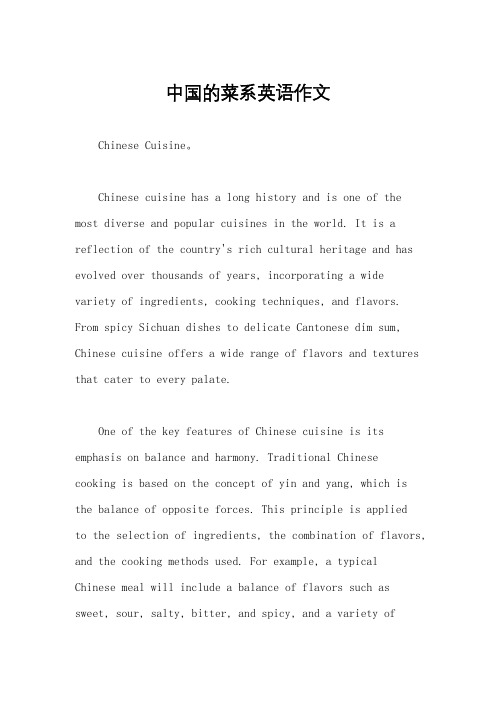
中国的菜系英语作文Chinese Cuisine。
Chinese cuisine has a long history and is one of the most diverse and popular cuisines in the world. It is a reflection of the country's rich cultural heritage and has evolved over thousands of years, incorporating a widevariety of ingredients, cooking techniques, and flavors. From spicy Sichuan dishes to delicate Cantonese dim sum, Chinese cuisine offers a wide range of flavors and textures that cater to every palate.One of the key features of Chinese cuisine is its emphasis on balance and harmony. Traditional Chinesecooking is based on the concept of yin and yang, which is the balance of opposite forces. This principle is appliedto the selection of ingredients, the combination of flavors, and the cooking methods used. For example, a typical Chinese meal will include a balance of flavors such as sweet, sour, salty, bitter, and spicy, and a variety oftextures such as crispy, tender, and chewy.Another defining characteristic of Chinese cuisine is its use of fresh and seasonal ingredients. Chinese chefs place a strong emphasis on using the freshest and highest quality ingredients available, and many traditional Chinese dishes are based on seasonal produce. This not only ensures that the dishes are flavorful and nutritious, but also reflects the close connection between food and nature in Chinese culture.Chinese cuisine is also known for its wide range of cooking techniques, which include stir-frying, steaming, braising, deep-frying, and roasting. Each technique brings out the unique flavors and textures of the ingredients and contributes to the overall complexity of Chinese dishes. For example, stir-frying is a quick and high-heat cooking method that preserves the natural flavors and colors of the ingredients, while steaming is a gentle and healthy cooking technique that retains the nutrients of the food.In addition to its diverse flavors and cookingtechniques, Chinese cuisine also has a strong cultural and social significance. Many Chinese dishes are associated with traditional festivals, celebrations, and rituals, and are deeply rooted in Chinese history and folklore. For example, dumplings are a symbol of wealth and prosperity and are traditionally eaten during Chinese New Year, while mooncakes are a traditional snack eaten during the Mid-Autumn Festival.Furthermore, Chinese cuisine has had a significant influence on the global culinary scene. Chinese dishes such as fried rice, sweet and sour pork, and Peking duck have become popular staples in many countries around the world, and Chinese restaurants can be found in almost every major city. The popularity of Chinese cuisine is a testament to its delicious flavors, diverse range of dishes, andcultural significance.In conclusion, Chinese cuisine is a rich and diverse culinary tradition that has a long history and a strong cultural significance. It is characterized by its emphasis on balance and harmony, use of fresh and seasonalingredients, wide range of cooking techniques, and cultural and social significance. Chinese cuisine has had a significant influence on the global culinary scene and continues to be a favorite among food lovers around the world. Whether you are enjoying a spicy Sichuan dish or a delicate Cantonese dim sum, Chinese cuisine offers a unique and delicious dining experience that is sure to satisfy every palate.。
中国菜英语作文
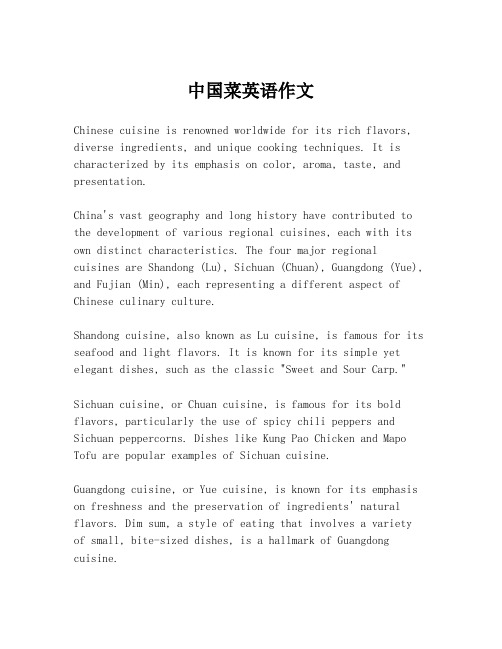
中国菜英语作文Chinese cuisine is renowned worldwide for its rich flavors, diverse ingredients, and unique cooking techniques. It is characterized by its emphasis on color, aroma, taste, and presentation.China's vast geography and long history have contributed to the development of various regional cuisines, each with its own distinct characteristics. The four major regional cuisines are Shandong (Lu), Sichuan (Chuan), Guangdong (Yue), and Fujian (Min), each representing a different aspect of Chinese culinary culture.Shandong cuisine, also known as Lu cuisine, is famous for its seafood and light flavors. It is known for its simple yet elegant dishes, such as the classic "Sweet and Sour Carp."Sichuan cuisine, or Chuan cuisine, is famous for its bold flavors, particularly the use of spicy chili peppers and Sichuan peppercorns. Dishes like Kung Pao Chicken and Mapo Tofu are popular examples of Sichuan cuisine.Guangdong cuisine, or Yue cuisine, is known for its emphasis on freshness and the preservation of ingredients' natural flavors. Dim sum, a style of eating that involves a variety of small, bite-sized dishes, is a hallmark of Guangdong cuisine.Fujian cuisine, or Min cuisine, is known for its use of seafood and its light, sweet flavors. Dishes such as Buddha Jumps Over the Wall are famous for their complex flavors and rich ingredients.In addition to these regional styles, Chinese cuisine also includes a variety of cooking methods such as stir-frying, deep-frying, steaming, and braising. The use of sauces and seasonings is also a key aspect of Chinese cooking, with soy sauce, oyster sauce, and sesame oil being common ingredients.Chinese food is not just about the flavors; it is also about the culture and the art of dining. The Chinese believe in the harmony of food and the balance of yin and yang in the ingredients. Eating together with family and friends is an important part of Chinese culture, and meals are often a time for socializing and bonding.As Chinese cuisine continues to gain popularity around the world, it serves not only as a culinary delight but also as a bridge for cultural exchange and understanding. Whether you are trying it for the first time or are a seasoned fan, there is always something new and exciting to discover in the vast world of Chinese cuisine.。
